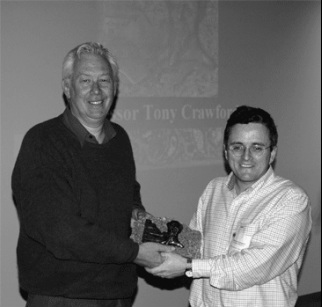A.J. (Tony) Crawford
2005
 Tony Crawford (left)
Tony Crawford (left)
Tony Crawford’s outstanding contribution to the comprehension of Victorian geology is in the area of the petrology and geochemistry of Cambrian igneous rocks and their implications for Victorian and Lachlan Fold Belt tectonics. Both his honours and doctoral studies were focused on the linear exposures of upthrust Cambrian rocks that frame much of Victoria’s Palaeozoic geology and, in the years since, he has continued with this work and published a series of important papers on Victorian geology and the wider Lachlan Fold belt.
Virtually nothing was known of the geochemistry of Victoria’s Cambrian metavolcanics before Tony undertook his B.Sc. (Hons) and PhD studies at the University of Melbourne. Those studies and his subsequent research permitted the recognition of three geochemical-tectonic associations within the metavolcanics: a latest Neoproterozoic rift–drift group, an intra-oceanic arc group, and a post-collisional group. Recognition of these associations has provided a means to relate the Victorian Palaeozoic and uppermost Neoproterozoic to parts of Tasmania, South Australia and New South Wales. Conversely, mafic–ultramafic complexes similar to the Cambrian igneous rocks of Victoria which Tony has studied in Tasmania are much better preserved there and permit the drawing of conclusions about Victorian tectonics beyond those reasonable if based on Victorian rocks alone.
Tony made the important recognition of the presence of boninitic basalts amongst the Cambrian metavolcanics of Victoria. Boninites distinctive high-magnesium basalts that are named after the Bonin volcanic arc in the western Pacific ⎯ are understood to be characteristic of an intra-oceanic island arc–backarc basin setting. His conclusion that the Lachlan Fold Belt (LFB) developed in such a tectonic setting is now supported in one form or another by most students of the LFB. Meanwhile, the interest in boninites stimulated by the Victorian rocks resulted in Tony editing the major reference on boninites (Boninites and Related Rocks, 1989, Unwin Hyman Ltd., London).
Industrial interest in the application of his broader LFB work to exploration in Victoria has fed demand for his workshops on the relation among petrology, geochemistry and fold belt evolution. His comparison of the Stavely volcanics in western Victoria with the richly mineralised Mt Read Volcanics of Tasmania has revealed strong similarities between the two.
Virtually nothing was known of the geochemistry of Victoria’s Cambrian metavolcanics before Tony undertook his B.Sc. (Hons) and PhD studies at the University of Melbourne. Those studies and his subsequent research permitted the recognition of three geochemical-tectonic associations within the metavolcanics: a latest Neoproterozoic rift–drift group, an intra-oceanic arc group, and a post-collisional group. Recognition of these associations has provided a means to relate the Victorian Palaeozoic and uppermost Neoproterozoic to parts of Tasmania, South Australia and New South Wales. Conversely, mafic–ultramafic complexes similar to the Cambrian igneous rocks of Victoria which Tony has studied in Tasmania are much better preserved there and permit the drawing of conclusions about Victorian tectonics beyond those reasonable if based on Victorian rocks alone.
Tony made the important recognition of the presence of boninitic basalts amongst the Cambrian metavolcanics of Victoria. Boninites distinctive high-magnesium basalts that are named after the Bonin volcanic arc in the western Pacific ⎯ are understood to be characteristic of an intra-oceanic island arc–backarc basin setting. His conclusion that the Lachlan Fold Belt (LFB) developed in such a tectonic setting is now supported in one form or another by most students of the LFB. Meanwhile, the interest in boninites stimulated by the Victorian rocks resulted in Tony editing the major reference on boninites (Boninites and Related Rocks, 1989, Unwin Hyman Ltd., London).
Industrial interest in the application of his broader LFB work to exploration in Victoria has fed demand for his workshops on the relation among petrology, geochemistry and fold belt evolution. His comparison of the Stavely volcanics in western Victoria with the richly mineralised Mt Read Volcanics of Tasmania has revealed strong similarities between the two.
